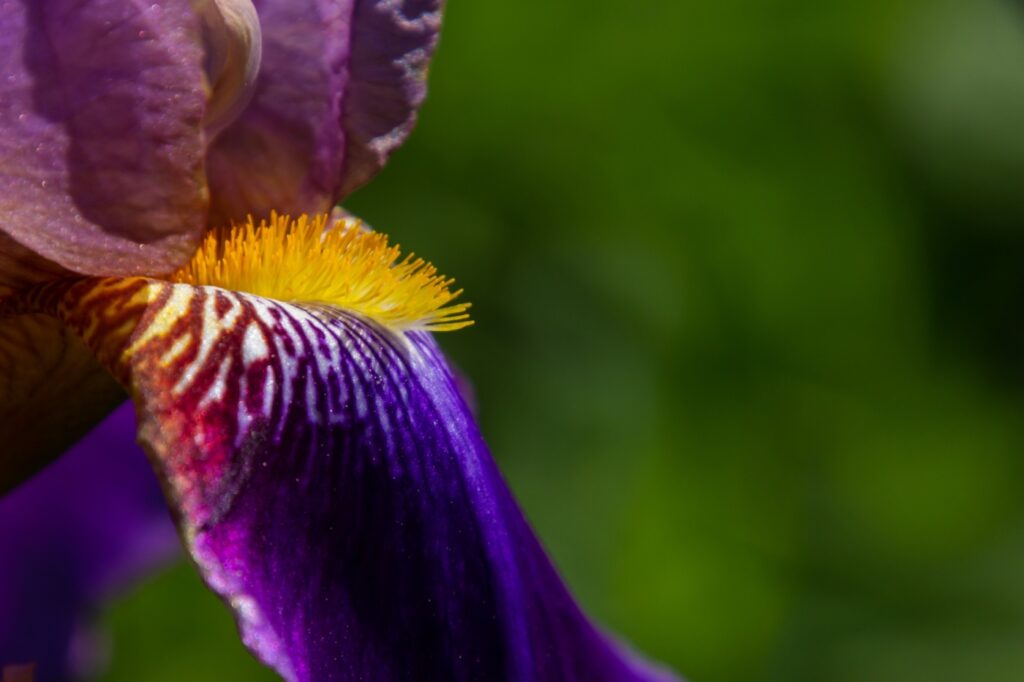
There is something truly special about purple flowers. They suggest royalty and stature. Whenever I see purple flowers, I linger for a while in their presence. Some purple flowers may appear violet, lavender, or mauve, depending on the time of day.
Perhaps the deepest, richest floral purple is found in bearded irises. They invite a tactile relationship due to their silky petal. In general, it seems that purple flowers cry out to be touched, perhaps because they are the classic color of velvet.
As we come to accept perennial drought in Southern California, few plants compare to bearded irises for drought tolerance. In truth, you never need to water them, as long as there is a pinch of winter rain, although they will put on more green growth and ultimately more flowers when they are regularly irrigated. Mulching, of course, will cut down on the frequency of irrigation. An iris bonus is that they are well-suited for cut flowers in vase arrangements.
Purple petunias go well with pink ones but also look surprisingly good with orange marigolds. You would probably never wear a purple shirt with orange pants but these two colors are surprisingly compatible in the garden.
When it comes to African violets, purple flowers are still the most common color seen, although blue, pink, and even yellow colors are now available. Their hirsute leaves are also touch-friendly, but this felty foliage is likely to become moldy from overhead watering. Thus, African violets are best placed in rimmed saucers so as to absorb water that is poured into them from below, keeping leaves dry. Make sure to empty the saucer once the soil is soaked since leaving any indoor plant in standing water may lead to soil fungus infestation.
There are a number of California natives with rich displays of purple flowers. Lupines are flowering now and penstemons will be blooming shortly. Wooly blue curls (Trichostema lanatum) have fuzzy flowers more purple than blue, and California bluebells (Phacelia minor) are the purple accents that pop up amidst expanses of California poppies.
Although most gardeners are probably familiar with the lavender-purple Mexican sage (Salvia leucantha), there are a large number of varieties of anise sage (Salvia guaranitica) with all manner of violet to purple blooms. Leaves are a minty green color and exude anise fragrance when crushed.
Now let me sing the praises of common heliotrope (Heliotropium arborescens). Its purple flowers are powerfully fragrant. Yet, while nearly all plants with fragrant flowers demand most of the day’s sun, heliotrope will tolerate no more than half-day sun. Bringing fragrance into a semi-sunny to shady garden is a rare treat, yet heliotrope provides it. Since its roots are shallow, it can be kept in a container for years, eventually reaching a height of four feet.
The purplest rose I have seen is a variety known as Ebb Tide. You can procure it at gardenia.net where it is described in these words: “Noted for its novel color and wonderful scent, Rosa ‘Ebb Tide’ is prized for its small clusters of large, four-inch across, very double, old-fashioned, deep smoky plum purple blossoms, packed with 35 petals. Rich of a strong clove and citrus fragrance, they bloom in flushes from late spring until frost.” To further enhance its garden worthiness is its status as a floribunda rose, which means it blooms most of the year in Southern California. While floribundas – white Icebergs most notable among them – are renowned for this ever-blooming proclivity as well as being pest and disease free, a strong floral fragrance is not one of their common characteristics.
Princess flower (Tabuchina urvilleana) is a pure delight. Large, irresistible lavender-purple flowers are complemented by velvety green leaves with thin red margins. Grow it in morning sun only. And don’t forget dwarf purple Peruvian lily (Alstroemeria sp.). She’s a charmer, too.
And then there’s queen’s wreath (Petrea volubilis), floral garb fit for a royal lady. When you first see it, you might mistake it for wisteria since wisteria and queen’s wreath are similar in their mix of lilac, blue, and purple colors and both display cascading sheets of flowers. But while wisteria blooms once a year, as winter turns to spring, queen’s wreath blooms now and as summer turns to fall as well. See a queen’s wreath blooming on the corner of Victory Boulevard and Ventura Canyon Avenue in Van Nuys.
If you have a plant with purple flowers that make you proud, you are invited to send me an email with details of its history and how you care for it.
Please send questions, comments, and photos to joshua@perfectplants.com.
